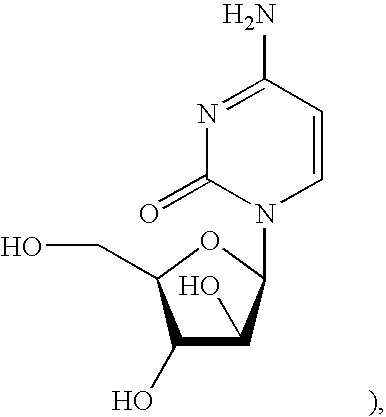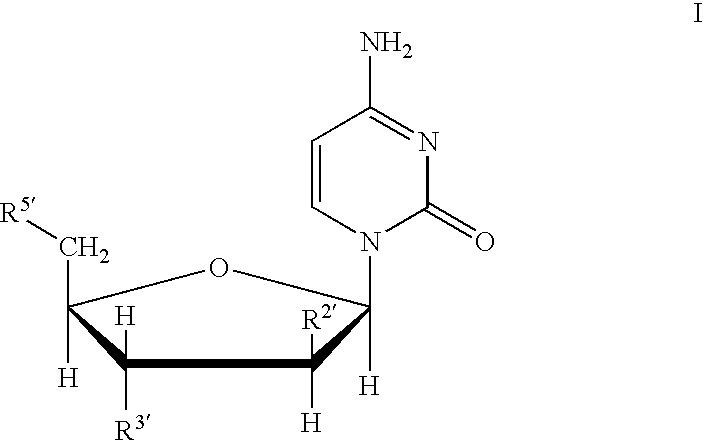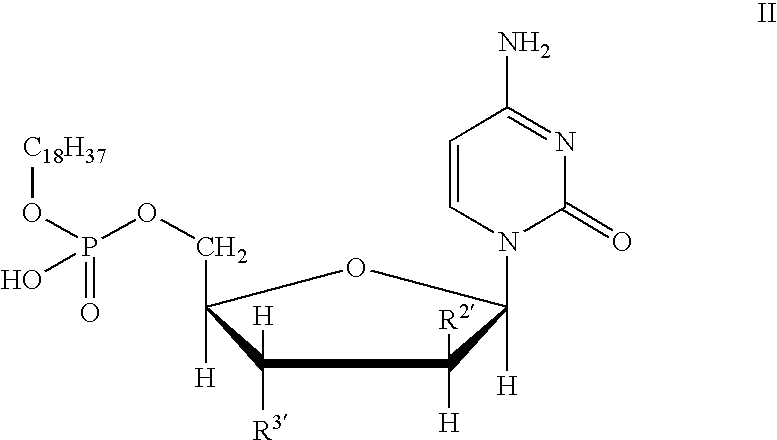Treatments for flaviviridae virus infection
a technology of flaviviridae virus and treatment, which is applied in the field of treatment of flaviviridae virus infection, can solve the problems that flaviviridae virus infections do not respond adequately to current treatments, and achieve the effect of preventing infection of the hos
- Summary
- Abstract
- Description
- Claims
- Application Information
AI Technical Summary
Benefits of technology
Problems solved by technology
Method used
Image
Examples
example 1
Production of Ara-C-5′-stearylphosphate (III) and Ara-C-5′-stearylphosphate monosodium salt
[0251] To 6.4 g (10 mmol) of N4, O2′, O3′-triacetyl-Ara-C-5′-phosphate tri-n-butyl ammonium salt, 5 g of stearyl alcohol, 30 ml of pyridine and 8 g of p-toluenesulfonyl chloride were added and the mixture was maintained at 40° C. for 3 hours. Then, the reaction mixture was extracted after adding 50 ml of water and 50 ml of chloroform.
[0252] Deacetylation of the triacetyl compound in the chloroform solution was carried out by adding 20 ml of aqueous ammonia and ethanol thereto and the deacetylated compound was extracted with water.
[0253] After collecting the aqueous layer, the aqueous layer was adjusted to pH 2.5 by adding conc. hydrochloric acid, and the precipitated Ara-C-5′-stearylphosphate was collected by filtration. After adding 20 ml of water to the thus obtained precipitates and adjusting the solution to pH 10.5 by an aqueous 1 N solution of sodium hydroxide, 80 ml of ethanol were ad...
example 2
Production of Ara-C-5′-stearylphosphate monosodium salt
[0255] Into 1.5 liters of water 500 g of Ara-C-5′-stearylphosphate were added and after adjusting the pH of the mixture to 10.8 by sodium hydroxide while stirring the mixture, 6 liters of ethanol were added to the mixture. After allowing the mixture to cool for 16 hours, the thus formed precipitate was collected by centrifugation to obtain Ara-C-5′-stearylphosphate monosodium salt in wet state.
[0256] By drying the thus obtained wet salt at 30° C. under reduced pressure, 332 g of amorphous (α-type) Ara-C-5′-stearylphosphate monosodium salt of m.p. 223° C. (decomposition) were obtained.
[0257] The purity of the thus obtained product was 99.5% according to liquid chromatography and E1 cm1% (273 nm, 0.1N NaOH) was 152. 3.
[0258] The same result as above was obtained when acetone, methyl ethyl ketone, tetrahydrofurane or dioxane was added instead of ethanol to precipitate the monosodium salt. This procedure is taken from U.S. Pat. ...
example 3
Production of Ara-C-5′-stearylphosphate monosodium salt
[0259] To 2.40 g of Ara-C-5′-stearylphosphate (a dried material), 6 ml of water were added and, after adjusting the mixture to pH 12.0 with aqueous 1N solution of sodium hydroxide, 30 ml of ethanol were added to the mixture and the mixture was stirred for 3 hours at 55° C. After cooling the mixture for 16 hours by standing, the precipitate was collected by filtration and dried for 10 hours at 30° C. under a reduced pressure to obtain 1.83 g of Ara-C-5′-stearylphosphate monosodium salt (α-type) of m.p. 220° C. (decomposition). The purity of the thus obtained product was 99.5% according to liquid chromatography and E1 cm1% (273 nim, 0.1N NaOH) was 150.9. This procedure is taken from U.S. Pat. No. 4,812,560.
PUM
| Property | Measurement | Unit |
|---|---|---|
| pH | aaaaa | aaaaa |
| pH | aaaaa | aaaaa |
| pH | aaaaa | aaaaa |
Abstract
Description
Claims
Application Information
 Login to View More
Login to View More - R&D
- Intellectual Property
- Life Sciences
- Materials
- Tech Scout
- Unparalleled Data Quality
- Higher Quality Content
- 60% Fewer Hallucinations
Browse by: Latest US Patents, China's latest patents, Technical Efficacy Thesaurus, Application Domain, Technology Topic, Popular Technical Reports.
© 2025 PatSnap. All rights reserved.Legal|Privacy policy|Modern Slavery Act Transparency Statement|Sitemap|About US| Contact US: help@patsnap.com



